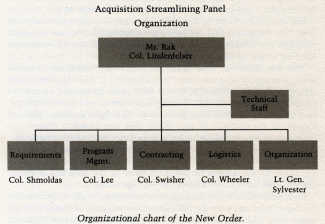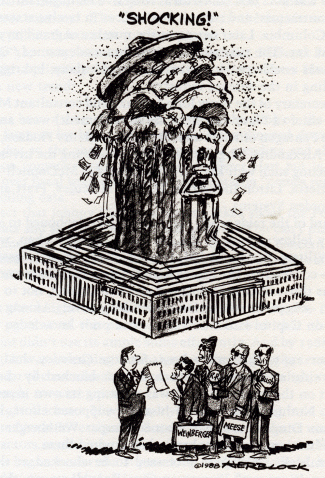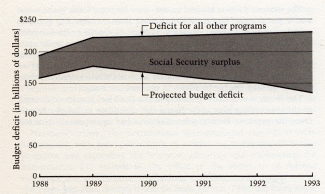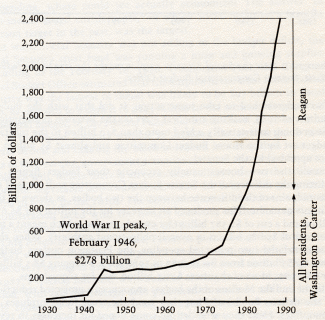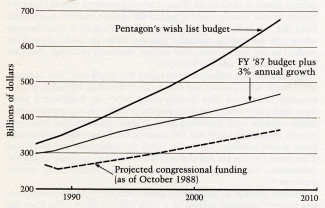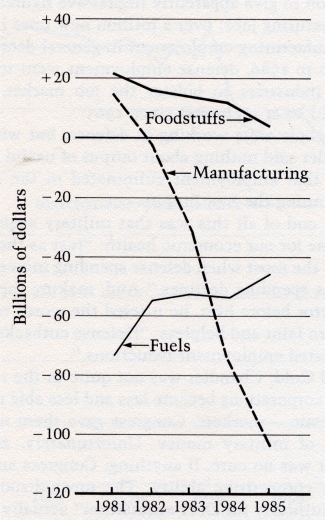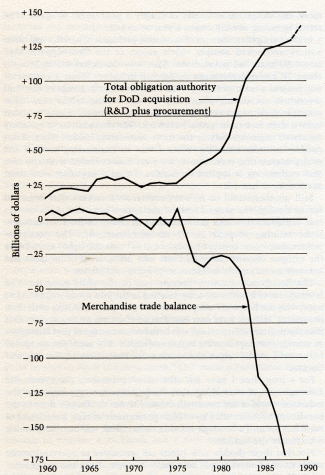By 1985, THE GUERRILLA MOVEMENT in Congress aimed at exposing the excesses of the military spending machine and trying to curb them was in full swing. The Pentagon quickly understood the present danger and wheeled up its big battalions for the attack. Ronald Reagan denounced the "incessant drumbeat of negativism" he heard coming from Capitol Hill and the press. The Air Force drafted new plans to interdict information. FBI agent Cavanaugh's testimony had been blocked. So had mine. But the Hill tribes were still restless.
Senator Charles Grassley of Iowa, the chief of the congressional mujaheddin, wanted to freeze the budget. He was one of the few public figures who had ever understood our message that the spare parts horrors reflected similar overpricing on the big stuff. In other words, he fully recognized that military airplanes, for instance, were collections of vastly overpriced spare parts flying in close formation.
On the other side of the aisle, Senator Proxmire and Richard Kaufman continued to pursue information developed at their 1984 hearings at which Amlie, Parfitt, and I had testified, much to the disgust of the Air Force General Counsel, who threatened us with the possibility of criminal prosecution if we revealed big contractors' excessive costs.
The Capitol Hill Military Reform Caucus, which included Senators David Pryor, Charles Grassley, and Nancy Kassebaum, and representatives Denny Smith, Mel Levine, Charles Bennett, and Barbara Boxer was also harassing the reckless spenders in the Pentagon. A true coalition from left to right, the Reform Caucus had fastened on the ultimate defense problem: the Reagan two trillion-dollar spend-up was producing very little in the way of better or better-equipped armed forces. The Pentagonists particularly hated Barbara Boxer because she had shamed them by exhibiting the $7,662 C-5A coffeepot, her symbol of contractor greed and Pentagon profligacy.
John Dingell, a member of the "College of Cardinals" -- the committee chairmen who run the show in the House -- had also joined the rebels. His exposure of the General Dynamics and Pratt and Whitney scandals in the first few months of 1985 had profoundly changed the politics of questioning Pentagon procurement spending. To the dismay of the old-line congressional establishment, Dingell seemed to have invaded the jurisdiction of the House Armed Services Committee, which had always been the cheerful rich uncle of the military spenders. No more blank checks, Dingell seemed to be saying.
It was time for the Pentagon to mobilize and put down the Hill tribes. The evil rumors of waste and corruption must be buried. How does one handle such a problem? If one is Caspar Weinberger, one first sets up something with a sweetness-and-light name like "Defense Council on Integrity and Management Improvement." To avoid the danger that the group might be influenced by its own name, one appoints a reliable undersecretary of defense like William Howard Taft IV to head it.
But someone like Representative Timothy Wirth always gets the idea wrong and wants to set up a new version of the World War II Truman Commission. Truman described that painful experience, which occurred during his vice presidency, to Merle Miller, his biographer:
Down at Curtiss-Wright at the airplane plant in Ohio, they were putting defective motors in the planes, and the generals couldn't seem to find anything wrong. So we went down, myself and a couple other senators, and we condemned more than four or five hundred of those engines. And I sent a couple of generals who'd been approving, who'd okayed those engines, to Leavenworth, and I believe they are still there. I certainly hope so.
That specter still haunted the Pentagon. Especially when Wirth's idea for a congressionally directed blue-ribbon commission began to gather support.
Representative Bill Dickinson, ranking Republican on the Armed Services Committee and Reagan's point man on military matters in the House, was worried. The Reaganites were protecting Pentagon waste, but he had supported me, and I was attacking waste, Apparently Dickinson, trying to work out a compromise between the ideas of the Taft figleaf council and the Truman junkyard-dog committee, urged Reagan to appoint his own blue-ribbon commission. He and the other kingpins on the Armed Services Committee might have been content with the Defense Council on Blah Blah if they hadn't viewed Taft as such a dumbbell. Taft had shown no talent at either substantive reforms or convincing cosmetic actions. Recall that it was Taft who announced that he had cured the spare parts cost horrors by abolishing "equal allocation of overhead" -- a method of accounting that had never existed.
Dickinson and his allies got the ball rolling on Reagan's blue-ribbon commission when Robert McFarlane, then head of the National Security Council staff, met with the president and agreed on a "bipartisan" membership. If one happened to be named Caspar Weinberger, one's reactions to this were deeply mixed. The Washington Post, on June 8, 1985, commented:
The Pentagon issued a statement yesterday saying that Weinberger "fully supports the concept of a presidential commission."
But senior Pentagon officials said Weinberger privately opposes the plan, feeling that it is criticism of his stewardship. He indicated his position by encouraging Deputy Defense Secretary William Howard Taft IV to hold a meeting of top Pentagon officials to work out procurement reforms. Weinberger scribbled a note in the margin of a memo from Taft that the meeting might be a "preemptive strike," according to one official.
The President's Blue-Ribbon Commission on Defense Management was established formally on July 15, 1985, by Executive Order 12526. The order immediately accomplished the first two objectives of any blue-ribbon commission: it bought time, by giving the commission nearly a year to work, and it changed the subject, by not mentioning any of the Pentagon bad smells, from overpriced spare parts and weapons systems to defective armament.
The message was clear to anybody who had ever padded a contract cost. It was also clear to Aviation Week and Space Technology, which reported on July 22, 1985, that "President Reagan created the commission in response to Congressional concerns that negative publicity about military procurement had produced a surplus of reactive, uncoordinated attempts at reform" (emphasis added).
Next came the choice of commission members. By time-honored rule, the majority had to be people strongly biased in favor of the establishment under examination and, furthermore, tainted by gross conflicts of interest. The members chosen by the administration passed this test with flying colors.
In naming David Packard as chairman, the administration couldn't have found a man better equipped with massive conflicts of interest. This multimillionaire industrialist, chairman of the board of Hewlett-Packard, a big defense contractor and a supplier to even bigger contractors, was also a member of Boeing's board of directors. And, as Nixon's deputy secretary of defense, he had managed the billion-dollar Lockheed bailout after the C-5A disaster. (Lockheed, of course, was a customer of Hewlett-Packard.) Packard held such a favored position that he wasn't required to divest himself of his stock in companies that had government contracts.
At the time of the Lockheed affair, the terms of the deal -- and Packard's role in it -- were not fully understood. Packard managed to make Congress and the press think he was going along quite reluctantly with the government loan guarantee. Behind the scenes, however, he was contriving to give Lockheed over a billion dollars more than the company had coming under the most permissive interpretation of their contracts. In addition, he let Lockheed off the hook when the C-5A transport failed to meet technical requirements. That, in turn, paved the way for another Lockheed bailout of $1.5 billion when the company had to make good its blunders in designing and manufacturing the plane's wings. Because of a media blackout at the time, the only near-contemporaneous account of how all this came about appeared in The High Priests of Waste. Apparently that fiscal atrocity was just too awful for the taxpayers to contemplate, so the big-time news people didn't cover it.
At the Pentagon Packard had greatly reduced civilian control over the military contracting community by putting "good" military officers in charge and "letting them alone." By the end of his tour, I had a much more accurate view of David Packard. He detested auditors almost as much as whistle blowers. As head of Hewlett-Packard in the 1960s, Packard had refused to allow the General Accounting Office to audit records of his company's negotiated contracts with the Pentagon. The GAO took the case to court and won, and won again on appeal. That victory may have had a bit to do with Congressman Chet Holifield's drive to halt the GAO from making direct audits of defense contractors, a drive that resulted in the neutering of the congressional watchdog.
The GAO's defense auditing role was then assigned to the Pentagon's Defense Contract Audit Agency, but as soon as Packard became deputy secretary, he set out to geld the DCAA as well. On October 9, 1970, he directed a memo on the defense contract auditor's role to the comptroller and to the Pentagon's chief buyer, both assistant secretaries. The memo said, "We should avoid actions by auditors in their advisory capacity which appear to dispute or question specific decisions of contracting officers." And, just to make sure that no bothersome questions about improper contracting got out, he added, "The escalation of possible disputes relative to specific decisions should be avoided."
When David Packard's appointment was being confirmed by the Senate in 1970, Senator Albert Gore, Sr., argued that Packard couldn't avoid conflict of interest by placing his stock in trust. Gore said:
What of the economic impact on the value of electronics stock five, ten, fifteen, or twenty years from now, if the Department of Defense, the President, and Congress decide, upon the recommendation of the Department of Defense, to launch upon a multibillion dollar deployment of antiballistic missiles? And what of the conflict of interest involved in the possible loss of value of the stock in case a decision is made to reduce the level of weaponry, and not to deploy ballistic missiles, but to decide upon a program of disarmament?
Packard himself has been quoted as saying, "I have an almost impossible conflict of interest." It didn't bother him much, however.
He very boldly attacked would-be military reformers and cost cutters, of whom I was one of the worst in his eyes. Packard's chance to denounce me publicly came when he reviewed The High Priests of Waste in the October 23, 1972, issue of Business Week.
What excited Packard most was my suggestion that the military budget should be cut to the point that people would have to make a practice of good stewardship. What was Packard's answer? More generals, fewer cost experts. He wrote:
With few exceptions, the military services have not assigned well-trained, competent officers to manage important programs.
Instead, a whole host of "experts" like Fitzgerald had been brought in to tell inexperienced managers how to manage these programs. ... I felt no need for his (Fitzgerald's) kind of expertise.
Then Packard blamed me for various management schemes, such as CWAS and "total package" contracts, that I had denounced in every possible way. When I read that, my head swam. Here was a man who, without careful editing, might accuse Hitler of being a pacifist or Yassir Arafat of being a nice guy. He saved his hardest rabbit punch for my budget-cutting proposal. He wrote, "This would, no doubt, please the doves in America and the hawks in Moscow and Peking."
The diatribe returned to Packard's familiar theme: "Get rid of all the Monday morning quarterbacks like Fitzgerald.... Put officers ... in charge" (my emphasis). And, further, let's have no more annoying schemes like should-cost measurement for reducing contract expense.
As I noted in Chapter 7, Packard was one of the hardy band of big spenders that called themselves the Committee on the Present Danger (CPD). Some of his co-conspirators were such Establishment figures as James Schlesinger, William Casey, John Lehman, Jeane Kirkpatrick, Max Kampelman, Paul Nitze, Richard Allen, Lane Kirkland, William R. VanCleve, and, most important of all, Ronald Reagan. As cochairman of the CPD and one of its most generous financial backers, Packard exerted a weighty influence.
In all, sixty of these present-danger watchers were appointed to high jobs in the Reagan administration, dominating arms control matters and the national security apparatus. The CPD was not shy about making this public, as its book, Alerting America, stated: "The Committee on the Present Danger has taken control of American national security policy."
Nor was the CPD reticent about military acquisition policy. According to the book, "We want prices and wages in the defense sectors to rise relative to prices and wages elsewhere enough to attract the labor and capital needed for the defense effort" (emphasis in original).
Thus, through David Packard and others, the philosophy of the CPD was transferred directly to the Packard blue-ribbon commission. What elaborate rituals of deception we go through in the government of the United States. The executive branch had, in effect, set up a commission to investigate an organization, the Pentagon, that was its identical twin in outlook and had an almost interchangeable membership.
The commission staff also arrived with conflict-of-interest luggage. Air Force Colonel James Lindenfelser, a competent technical man, was best known for his public defense of the $7,622 coffee pot. Rhett B. Dawson had been chief of staff for Senator John Tower, chairman of the Senate Armed Services Committee. One senior consultant was Vincent Puritano, formerly one of Weinberger's assistant secretaries, whose notable effort in office was putting down George Spanton. Defense industry consultant Jacques Gansler, former CIA flack Captain Herbert E. Hetu, USN, retired -- and so the list went, thoroughly Old Boys in this Old Boy network.
Any able bureaucrat-manipulator worth his invitation to the Inaugural Ball knows the blue- ribbon commission tactics. You have some show-biz public hearings for the media and you do your real business behind closed doors. For the sake of the media, you invite some of the critics to testify in public; but in secret sessions, forget it.
In early December 1985, David Berteau, the commission's executive secretary, talked with me about giving testimony. In the days when Dave had been an assistant to Vince Puritano, he had seemed sympathetic to our cause. I'd always considered him a straightforward man, and he hadn't changed: he said quite frankly that the open hearings were for "public show" only.
I asked him how the commission was going to get around the "Sunshine Law," which required that all hearings be public unless they concerned genuine national security matters.
He said that the DoD was "executive agent" for the commission and could grant Packard the right to secret sessions whenever he asked. He added that Packard had had a long session about this with General Larry Skantze, chief of the Air Force Systems Command and number-one opponent of the more-bang-for-the-buck underground.
As for my own testimony, Dave was perfectly candid: some of the commission members were interested in hearing me, but what I had to say would have no influence whatever on the commission. The same would be true of any other dissidents.
At this point, the president sent his military budget to Capitol Hill, where it was declared dead on arrival. Clearly the administration couldn't wait until June, when the Packard Commission report would create a diversion. The natives had ambushed the Pentagon machine and were definitely restless: reform legislation had been introduced in both houses.
The administration cleverly initiated a PR blitz by planting reports of an internal battle within the Packard Commission and leaking a few interesting documents to media people who wouldn't ask too many questions. Commission member James Woolsey, so ran the tale, had drafted a rogue report that was "contentious" and "highly unflattering" to Pentagon management, and the other members were sharply divided over it. The only trouble with this story was that Woolsey was an old-line Pentagon team player and a staunch member of the big-spender club.
Those reporters who were considered too nearsighted to recognize a trial balloon when they saw one -- or too innocent to shoot it down if they did -- got copies of the hundred- page Woolsey report. They dutifully filed stories but, by significant coincidence, the stories did not detail Woolsey's actual findings or recommendations.
The counterpuff was not long in coming. David Packard began to confide in the Defense Department critics, telling them that in his heart he was really in favor of their tough line but that political considerations kept him from saying it in public. He assured them they would have his behind-the-scenes support.
It was time to throw Ronald Reagan into the mock battle. On February 10, 1986, he again charged the drummers, saying that the American Taxpayer had heard "a constant drumbeat of propaganda about defense scandals and defense spending and all that is wasted." The Packard Commission was going to be the only answer "in the face of this propaganda."
Uh-oh, David Packard whispered to the media, in the face of Reagan's statement, he couldn't possibly come up with a really tough report. The president would be bound to reject it. Instead, Packard produced an "interim report," a flimsy affair of twenty-six nominal pages. (A final report appeared months later.) One full page listed the commission members, another page listed staff members, pages four, twenty-two, and twenty-six were blank, page twenty-five carried an eight-line conclusion that said nothing. The remaining twenty pages covered the subject of procurement so superficially that they were hard to take seriously. The dubious substance of the report was that Packard was in favor of "contractor self-governance," to be effected by asking contractors to "implement internal controls" over their business ethics. The Department of Defense was encouraged to "vigorously administer current ethics regulations."
Packard was especially worried that somebody might be prejudiced against contractors with a bad record; in Pentagonese, he wanted to limit suspension and debarment to unethical "ongoing conduct." He didn't want them held responsible for their past sins, just for crimes in progress. It was like arguing that crooks should be punished only while they were actually stealing, mugging, or raping.
Our defenses against collusive fraud -- bribes, kickbacks, overbuying and overpricing, "material shrinkages," and the like -- were already woefully weak. Now the big spenders, undaunted by known defalcations and those lurking just beneath the surface, were proposing to strip away most of the remaining safeguards.
The Packard interim report may have looked like a joke and read like a joke, but the laugh was very brief. Soon there were signs that business and the Establishment press were going to give it a lot of weight. A number of our reporter friends had been telling us for some time that it was becoming ever harder to sell their bosses stories critical of the Pentagon. After all, most of the news media lords were part of the business establishment and shared their brethren's distaste for our populist uprising. Most establishment figures seemed tired of the drumbeat of negativism, tired of hearing stories about simple spare parts that cost as much as if Tiffany's had made them out of platinum, tired of tales about costly military hardware that didn't work, and, most of all, tired of taxpayers in a state of shock. It was all very bad for business. They seized on the Packard report as an opportunity to declare a victory.
The House Armed Services Committee scheduled hearings on the report for March 5, 1986. To prepare the way, the Pentagon machine laid down a rolling barrage of flackery. Weinberger appeared on CBS's "Face the Nation" on March 2 and gave a perfect rendition of a high official forced to accept the "tough" Packard recommendations. Drama critics would have given him excellent reviews. On March 3 the Wall Street Journal quite seriously reported this and other aspects of the sham battle among the Pentagon titans.
The New York Times on March 5 contributed its bit with an editorial titled "The Packard Bombshell." It was a superb job of ignoring the disastrous recommendations that actually appeared in the report and finding comfort in reading between the lines. The Times said, "The commission implies" criticism of Congress for using the weapons-buying process for the "distribution of weapons contracts and jobs." There were no such words in the Packard report.
The House Armed Services subcommittee hearings opened that morning. Chairman Bill Nichols of Alabama introduced Congressman Dickinson as the man "whose idea resulted in the creation of the Packard Commission." Dickinson said how much he had been gratified by the Times editorial and, addressing David Packard, said that the committee's job in dealing with the defense and appropriations bills would be helped along "if we can get public sentiment behind your commission." The violins were already launching into "Hearts and Flowers."
David Packard was treated with the worshipful deference that is a billionaire's due. His commission had so successfully changed the subject that he felt it unnecessary to go into such disagreeable matters as the procurement fiascoes. It was much more uplifting to philosophize about the organization of the Joint Chiefs of Staff and matters of grand strategy.
His incidental mentions of procurement simply repeated the familiar Packard chestnuts about "contractor self-governance" and the need for "a more productive partnership between government and industry."
There were a few serious questions from some of the representatives. Congresswoman Boxer asked why the commission was against letting the DoD use investigative subpoenas when looking into alleged misdeeds by contractors.
That would discourage contractor "self-governance," Packard said. When she asked why Packard had not endorsed a civilian procurement corps instead of a military officer- nominated one, his response was minimal and unilluminating.
Congressman John Bryant asked the toughest question of the day. Who was responsible for putting that outrageous "only the crimes in progress" clause in the commission's report?
The prime movers, said Packard, were "Bill Clark and Carla Hills." Judge William Clark, who had been NSC staff chief before Robert McFarlane, was now working as a partner in the law firm of Rogers and Wells, Lockheed's lawyers. Carla Hills was senior partner in the huge corporate law firm of Latham, Watkins and Hills, whose many defense contractor clients included Hughes Aircraft. But nobody thought to remark on Emperor Packard's new clothes. In the Reagan era, let it be remembered, such conflict-of-interest nudity seemed taken for granted.
Congressman Mel Levine, known as a reformer who might be critical of the Pentagon, was allotted just thirty seconds for questioning. Ron Wyden asked a question about unpriced contracts like the one for the $8,832 pulley puller that should have cost no more than $69. Packard answered obscurely and wouldn't make any commitments about correcting the practice.
Packard's back-up witnesses were Frank Carlucci (later secretary of defense), retired Army General Paul Gorman, retired Admiral James Holloway (a Washington lobbyist and consultant to the big brokerage house of Paine Webber Mitchell Hutchins) and retired Air Force General Brent Scowcroft. No congressman asked any of them about their possible conflicts of interest.
In the end the administration had pulled it off. Almost all of the people had been fooled at least part of the time. The commission's work was hailed on Capitol Hill; the Pentagon was ecstatic. On March 12, National Security Adviser John Poindexter wrote Weinberger a SECRET memorandum noting that this "most favorable" reaction in Congress would give "the President considerable leverage in dealing with the more radical proposals for reform that abound in both Houses." He asked for Weinberger's comments on an attached draft of a secret National Security Decision Directive (NSDD) that would "implement" the Packard program.
At nine-fifteen on the morning of March 13, I was given copies of this memo, the draft directive, a proposed presidential press release backing the Packard Commission and extending its term, and a draft of a presidential letter of endorsement to be sent to the speaker of the House and the president of the Senate. I was given just an hour and a quarter to write my comments on all this. Poindexter explained in his cover note to Weinberger that the directive was designed to strengthen the secretary's hand against the pending reform legislation and to ensure his control over any enforcement of reforms.
In short, the serious fix was in. The only reason all this was classified as secret was to hide the fact that the Packard exercise was indeed antireform. As I wrote my hasty comments, I had an ominous feeling that the big payout machine was about to win. The victory was proclaimed by the White House on April 2 with a press conference to signal acceptance of the Packard recommendations.
The final document was a National Security Decision Directive titled "Implementation of the Recommendations of the President's Commission on Defense Management." With minor changes, this was the same garbage that Poindexter had sent to Weinberger in draft form along with his SECRET memo. The directive produced a small mystery. We discovered that there were two versions of it: the official, public one, which was undated, and a classified one designated NSDD 219. When we obtained a copy of the classified version from Lieutenant Colonel Bill Byrne of the acquisition management office I found that the effective date was April 1 -- April Fool's Day -- 1986. On the signature page was a hand-drawn X ("his mark"?) and next to it a signature that read "Ronald Reagan." But Reagan was on the West Coast the day the paper was issued from the White House. Could it have been that the White House auto-pen was having an April Fool's joke on the country?
After Packard's triumph on March 5, the administration sent him back to the Hill for a mopping-up operation before committees in the House and Senate. As befitted a victor, he was greeted with flowers of rhetoric and exaggeration. "You are a perfect example of complete ethics in government," said Congressman Charles Bennett. "I've often cited you as that."
Congressman Dickinson quoted Packard's former military aide, Ray Furlong. "He said, in looking over your proposals, that you had the same idea then fifteen years ago and you hadn't changed your mind yet. Is that right?"
Packard answered: ''That's about right."
Right. And the results of those "same idea(s) fifteen years ago" had been order-of- magnitude price increases, technical weaknesses in our big weapons systems, and a sapping of American industrial competitiveness.
Packard's afternoon at the Senate was even more of a love-in. Senator Sam Nunn, thanking Packard for his sterling effort, said, "Senator Goldwater and I stayed in touch with Mr. Packard and other members of the commission for many months of their hard work." Goldwater, more florid, said, "I have followed David Packard on this thing since the day he has gotten in town, and every time he had the answer I went to sleep with it and enjoyed sleeping with it very much." Then Goldwater went on to produce the most thunderous false prophecy of the year:
I am thinking, for example, of the B-1, at one time one of the most expensive programs we ever conceived, but under proper uniform management, the aircraft was being brought in under cost and ahead of time. That is what we are after (emphasis added).
At that time the catastrophic failures of the B-1 were still under wraps of secrecy. But Goldwater turned out to be right about one thing: the B-1 debacle was a splendid example of what David Packard's reforms had to offer.
The administration moved immediately to solidify its victory. On April 10, D.O. Cooke, deputy assistant secretary of defense, issued formal orders for "implementation" of the Packard Commission's recommendations. All this congressional and bureaucratic approval came, oddly enough, before the final Poindexter-Packard report was made public on July 2. When that happened, my associates and I saw full confirmation of the bad news.
The bad news wasn't so much the report's separate recommendations -- we were prepared for all of those -- it concerned a bigger concept: the long-established set of rules for organizational checks and balances. In a large bureaucracy it is important to have different offices and agencies check on one another's activities to inhibit collusive fraud.
In June 1988, when the news of the Pentagon scandals broke, few people seemed to realize that actions such as Packard's had invited the corruption the FBI investigation was bringing to light. When ABC's David Brinkley discussed the matter with a panel on his "This Week" program on June 26, 1988, the question heard again and again was, "How did this happen? George Will asked, "Why, in the middle of 1988, is this suddenly erupting like Vesuvius in a meadow -- as if no one had any inkling?"
Part of the answer lies in Packard's recommendations, and those of other high administration officials, in regard to cross-checking, auditing, and overseeing. "But what about the guards?" Sam Donaldson asked the two defense-contractor representatives on the panel. Was there no one responsible for preventing such abuses as collusion between corrupt officials and crooked industry consultants?
The answer, from Donald Fuqua of the Aerospace Industries Association, missed the point: he did not believe that secretaries Weinberger and Lehman were personally responsible for laxity. No one pointed out that the relaxation of independent vigilance and the crippling of cross-check authority under Reagan had led to the greatest opportunities for waste and conspiracy.
From the start the Reagan administration was opposed to such checks. In 1981 administration appointees in the GAO brought in a new procedure that was an obvious sham. Instead of offices or organizations being responsible for checks and balances individual people would be. Thus an inspector might report to a manufacturing manager one on one. Without the oversight function of an independent office, if the inspector and manager connived with each other, no one would know the difference. The perpetrators of this atrocity were appointees from the big eight CPA firm of Arthur Andersen and Company, advisers to the Packard Commission.
It is easy to see how this company's Packard Commission work, entitled "A Study of Government Audit and Other Government Oversight Activities Relating to Defense Contractors," might be tainted by a gross conflict of interest. Among Andersen's big contractor clients was General Dynamics, then under investigation by Congressman Dingell's committee.
Even more telling was the fact that the Andersen study faithfully paralleled the October 2, 1985, recommendations to Packard from the National Security Industrial Association (NSIA). This organization, a creature of the big contractors, was established to make known their views on "contracts, production procedures, specifications, and requirements." Its October 2 letter complained at length about "overregulation and micromanagement on the part of Congress and the DoD." In other words, the association was worried about increasing oversight. Arthur Andersen's report agreed that that was a bad thing.
NSIA said that "in recent years, the authority of the contracting officer has been whittled away" and that pushy auditors should be put back in their place. Andersen's report echoed that in slightly different words. NSIA said that Congress ought to declare a "moratorium on procurement legislation." Andersen said, "There should be a moratorium on the issuance of new procurement laws and regulations affecting defense contractors."
But one of the worst mischiefs of the Packard reforms was the insistence, fully endorsed by his CPA firm consultants, on the Pentagon's cost-justification rule. The cost-plus formula had proved to be such an easy rationalization for high prices as to make stealing seem legal. "One definition of a fair and reasonable price . .. is a price that closely approximates the seller's cost to make or acquire the part plus a reasonable profit." This, of course, was the antithesis of the honest should-cost yardstick my colleagues and I had so long advocated.
The Packard Commission asked the CPA firm of Peat, Marwick, Mitchell and Company, auditors for General Electric and other military contractors, to review the audit and control recommendations in its report. Peat, Marwick was concerned with "necessary benchmarks for establishing the composition of the 'costs' of contract performance." Their report favored proper "assignment of costs to final cost objectives, or the allocation of costs to contracts."
This meant that contractor companies should submit a clean sheet for any claims, a sheet without errors and with no illegitimate items. In other words, all the numbers had to foot and cross-foot, and any charges for bribes or whores had to be well disguised.
The Packard Commission had a habit of going to poisoned -- or at least tainted -- wells. There was the matter of businessmen's ethics in the contractor "self-governance" clause. Packard hired a consultant firm called the Ethics Resource Center (ERC) to write the "Conduct and Accountability" portion of his report. After conducting a survey of defense contractors, the ERC recommended that they adopt unambiguous codes of ethics. It failed to address how Sunday School lessons would impress the Hell's Angels or whether contractors who made their profits because they had no ethics would be converted by lectures to the ways of righteousness.
This performance drew the attention of the Project on Military Procurement, which looked into the background of the ERC. It reported:
The Center has received significant amounts of money from corporations that have been found to be guilty of misconduct. Ethics Resource Center sets up programs for companies, working on such a program for General Dynamics just before working on the report for the Packard Commission. (ERC) received $30,000 from General Dynamics. GD had contacted ERC immediately after being suspended for misconduct. The Center also received money from McDonnell Douglas while that company was being investigated for misconduct, and from Clifton Precision after that division of Litton was suspended. The Center wrote, in the conclusion of its report, that many defense contract firms have taken significant action to establish, communicate, monitor, and enforce policies and procedures to ensure a high level of business conduct. In each area, actions could be improved upon.
As Juvenal asked, "But who is to guard the guards themselves'" (sed custodiet ipsos Custodes!). Who teaches ethics to the Ethics Resource Center?
The only newspaper I knew of that was willing to report the flaws in the Poindexter- Packard report was the Boston Globe, which carried Fred Kaplan's comprehensive account on July 27, 1986. Most of the press had been fully and truly conned, however. A typical headline would be: DEFENSE CONTRACTORS ASKED TO POLICE THEIR EMPLOYEES, and the story would cite contractor self-governance as a part of the Pentagon's "get-tough" policy. The bitter harvest of our laxity, capped by this self-governance policy, was to come in June 1988 with the news that fifteen large defense contractors, a number of defense consultants, and at least six Pentagon officials were targets of FBI investigations into collusive fraud.
The central purpose of all the testimony, reports, and directives, of course, was to influence the bill Congress was putting together. The Air Force launched its own lobbying effort and at the same time set up a "study" group under the rubric of the Acquisition Streamlining Panel, headed by Dan Rak, deputy to the Air Force assistant secretary in charge of acquisition, but otherwise dominated by military officers.
Meanwhile Congress was fighting a sharp behind-the-scenes battle over the Poindexter- Packard plan. Most of the big spenders pushed for the recommendations in the report -- in effect, putting the military in charge. Traditionalists on the armed services committees, under severe pressure from the reformers, fought for a broad commitment to civilian control.
Who finally won the battle of Goldwater-Nichols, Public Law 99-433, on October 1, 1986? On the one hand the law provided for an Air Force inspector general who would be "selected from the general officers of the Air Force." It also required that all of his deputies be "officers of the Air Force." On the other hand, its first stated purpose was "to reorganize the Department of Defense and strengthen civilian authority." That language gave comfort to the Capitol Hill reformers and to me. We hadn't quite reckoned with the awesome duplicity power of the U.S. Air Force.
Its foresight in setting up the Acquisition Streamlining Panel, a so-called study group, was now about to pay off. Strategy? Simply ignore the Goldwater-Nichols commitment to civilian control and shift as much power as possible into the hands of the military. On November 24 the panel submitted its report for reorganizing the Air Force acquisition system. Instead of Goldwater-Nichols, the report took as its overriding authority NSDD 219. And, most ominously, the panel called its proposed plan "the New Order." It took considerable arrogance to produce that name. Adolf Hitler's "New Order in Europe" was only forty-one years in the past.
The civilian side of Air Force headquarters is the Secretariat; the military side the Air Staff. Goldwater-Nichols forbade the Secretariat from surrendering certain controls to the Air Staff. But the New Order got around that by delegating those controls to the next lower levels of military command -- the Systems Command (AFSC) and the Logistics Command (AFLC). The areas delegated to AFSC and AFLC were:
Refunds. Verne Orr had used this authority to try to recover some particularly horrendous overcharges for spare parts from contractors. The generals bitterly resented this because it spotlighted their giveaways.
Progress payments. Under the old system, John Boddie, a deputy to the assistant secretary for financial management (SAF/FM), was responsible for making payments on contracts. We had started a promising scheme called "Quality Control and Cost Control at Point of Payment," meaning that if the contractor's work was done on time and up to standard, he would be paid the agreed-on price. Progress payments were supposed to depend on genuine progress.
Work standards. The military would now decide whether contractors should live up to the Military Standard for work measurement. (Assistant Secretary Carver had already taken this out of my hands in 1985.)
Authority to grant contracts in the face of protests. The right to proceed with contracts in spite of charges of irregularity was transferred from the Air Staff to the four-star purchasing commands.
Authority to approve multiyear contracts. This was transferred from the Air Staff to the AFLC and the AFSC.
The last two shifts evaded Goldwater-Nichols by quickly transferring areas of power to the four-star commands before they had to be turned over to the Secretariat.
Along with all this, the New Order gave most of the purchasing authority to a three-star general, the director of acquisition, with a staff of four hundred people. The new civilian assistant secretary for acquisition had a handful of people and a lesser role.
The New Order wasn't classified as secret, but it was considered "close hold." Nevertheless, the scheme was revealed when a closet patriot gave it to the Project for Military Procurement, which gave it to the press on February 26, 1987. This produced a small revelation of another kind: the press was quite as ignorant of modern history as the military: almost no reporter had heard of Adolf Hitler's New Order. Hitler gave the world fair warning in Mein Kampf of what he was up to. And our own military and their allies have given us fair warning of their uses of the Wehrwirtschaft.
Was the New Order takeover uncongenial to the administration appointees in the Pentagon? Not at all. Air Force Assistant Secretary Carver was agreeable; the military had promoted him to be a full colonel in the reserve. Undersecretary Aldridge had been part of a move to set Parfitt and me up for possible criminal prosecution and contractor damage suits in retaliation for our congressional testimony. And the new undersecretary of the Air Force, James McGovern, was an important figure in the New Order. As Goldwater's Armed Services Committee staff director, he had not been notable for being tough on the military spending coalition.
I tried a number of times to arrange a meeting with McGovern or Aldridge to work out our differences, but the attempts were ignored. Representatives Dingell and Aspin wrote to Weinberger protesting the coup but were brushed off. Under their commander in chief, the military were marching resolutely toward the New Order.

